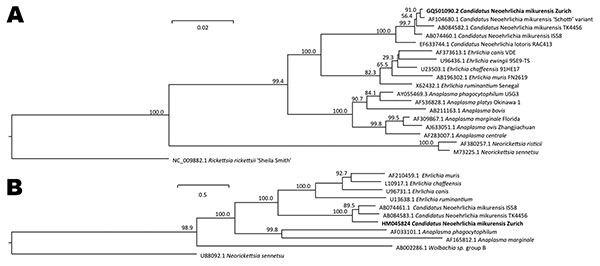Volume 16, Number 7—July 2010
Dispatch
Septicemia Caused by Tick-borne Bacterial Pathogen Candidatus Neoehrlichia mikurensis
Figure 2

Figure 2. A) Phylogenetic tree based on the 16S rRNA gene sequences of Candidatus Neoehrlichia mikurensis GQ501090.2 (our patient’s isolate, herein termed Zurich and indicated in boldface) and related organisms. The number at nodes indicates percentages of bootstrap support based on 10,000 replicates. Scale bar indicates 0.02 substitutions per nucleotide position. B) Phylogenetic tree based on the groEL sequences. Scale bars indicate 0.05 substitutions per nucleotide position.
Page created: March 02, 2011
Page updated: March 02, 2011
Page reviewed: March 02, 2011
The conclusions, findings, and opinions expressed by authors contributing to this journal do not necessarily reflect the official position of the U.S. Department of Health and Human Services, the Public Health Service, the Centers for Disease Control and Prevention, or the authors' affiliated institutions. Use of trade names is for identification only and does not imply endorsement by any of the groups named above.